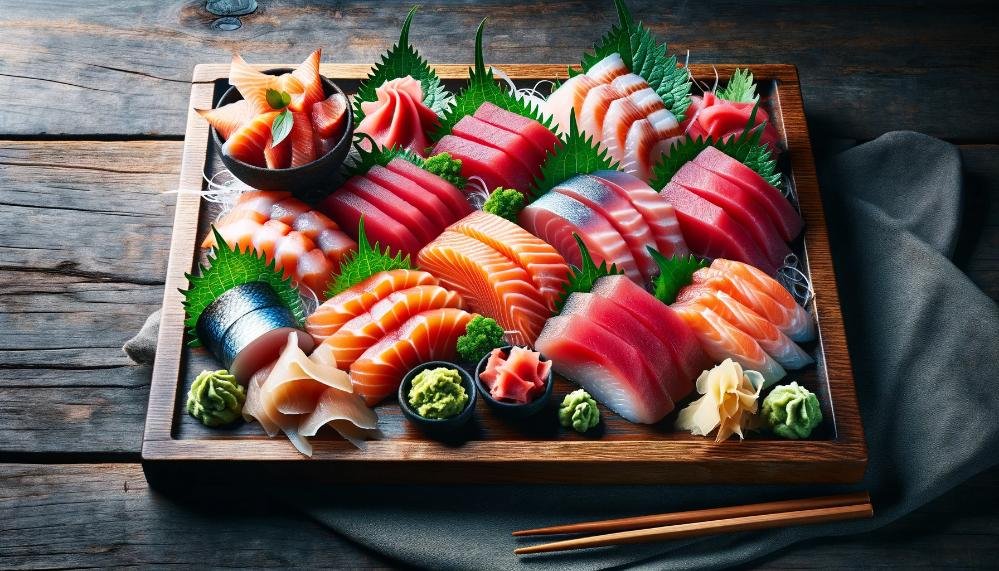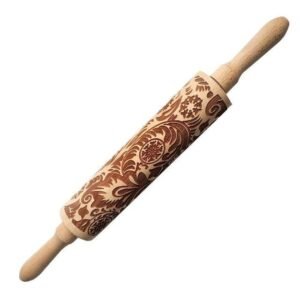Introduction
Sashimi, a beloved delicacy originating from Japan, has captivated taste buds worldwide with its fresh raw seafood and meat. From sushi rolls to nigiri, sashimi offers a variety of options for sushi lovers. This exquisite dish showcases the art of serving raw fish and seafood, including chicken sashimi, in its purest form. It is a staple in Japanese cuisine, often served in sushi rolls or as zukuri cut meat. With its cultural significance deeply embedded in Japanese culinary heritage, sashimi offers a unique dining experience that goes beyond a mere meal. Served as sushi rolls, this food showcases the art of zukuri and the precision of the cut.

The foundation of sashimi lies in the meticulous selection and preparation of fresh ingredients for sushi rolls. The ingredients are carefully cut and prepared using the traditional zukuri technique. From succulent slices of chicken sashimi to buttery salmon sushi rolls, each cut delivers an explosion of flavors that is both refreshing and indulgent. The delicate balance between the coolness of ice and the vibrant colors of chicken sashimi on the plate adds to the visual appeal of this cut gastronomic masterpiece.
Whether you are an adventurous foodie or a connoisseur seeking traditional sushi experiences beyond sushi rolls and nigiri, sashimi presents an opportunity to cut embark on a culinary journey like no other. Join us as we explore the world of sashimi, discover its diverse cut offerings, and unlock secrets to elevate your dining experience.
Defining Sashimi and Its Cultural Significance
Sashimi, often referred to as a delicacy, is a dish consisting of thinly sliced raw fish or seafood that is cut into precise pieces. This traditional Japanese cuisine has a long history that dates back to ancient times. It is known for its precise and skillful cutting techniques. Sashimi holds great symbolic importance and is often served on special occasions, reflecting elegance and purity.
Definition of Sashimi
Sashimi is a Japanese culinary delicacy renowned for its simplicity and emphasis on fresh, high-quality ingredients. Derived from the term “sashi” (pierced) and “mi” (flesh), sashimi traditionally consists of thinly sliced raw fish, skillfully presented without any rice. The dish showcases the natural flavors and textures of the seafood, often served with soy sauce, wasabi, and pickled ginger. Common fish varieties used for sashimi include tuna, salmon, and yellowtail.

Historical Roots
The origins of sashimi can be traced back to ancient Japan, where it was initially consumed as a method of preserving fish. Fishermen would catch their daily hauls and preserve them by salting or pickling them in rice vinegar. Over time, they discovered that slicing the fish thinly allowed for faster preservation while still maintaining its taste and texture.
As time went on, sashimi evolved from a preservation technique to an exquisite culinary art form. It became popular among nobles during the Edo period (1603-1868) when Japan experienced a flourishing food culture. Chefs began refining their techniques for slicing fish with precision, creating visually stunning presentations that showcased both skill and creativity.
Symbolic Importance
In Japanese culture, sashimi holds significant symbolic importance beyond its culinary appeal. It is often served during special occasions such as weddings, birthdays, and New Year celebrations. The presentation of sashimi represents elegance and purity, making it an ideal choice for auspicious events.
The vibrant colors of various types of sashimi reflect celebration and joyous moments in life. For example, red tuna symbolizes good luck and prosperity while white fish like flounder represents purity and new beginnings.
Sashimi is also considered a form of respect towards the ingredients. The freshness and quality of the fish or seafood are paramount, emphasizing the importance of using only the best ingredients available. The delicate slicing technique further showcases the chef’s skill and dedication to preserving the natural flavors and textures.
Sashimi Versus Sushi: Key Differences
No Rice Involved
Sashimi and sushi may both be popular Japanese dishes, but one key difference sets them apart. Unlike sushi, sashimi is completely rice-free. While sushi features a combination of vinegared rice and various toppings, sashimi focuses solely on the fish or seafood itself. This means that when you indulge in sashimi, you’re experiencing the pure and unadulterated flavors of the seafood without any interference from rice.
Focus on the Fish
The main star of the show is undoubtedly the fish or seafood. The emphasis lies in highlighting and appreciating the natural flavors of these ocean delicacies. Whether it’s melt-in-your-mouth tuna, buttery salmon, or delicate white fish like flounder or snapper, each slice of sashimi aims to showcase the unique taste and texture of the seafood. The simplicity of sashimi allows you to truly savor every bite and appreciate the freshness and quality of the fish.
Presentation Style
In terms of presentation, sushi rolls are often associated with intricate designs and creative combinations. On the other hand, sashimi takes a more minimalist approach with its artful arrangements of thinly sliced fish or seafood. The slices are usually arranged meticulously on a plate, creating an aesthetically pleasing display that showcases not only the vibrant colors but also highlights different textures within each piece. This attention to detail in presentation adds an element of elegance to sashimi dining experiences .
While both sushi and sashimi offer delightful culinary experiences centered around fresh seafood, their differences lie in their composition and presentation styles. Sushi combines vinegared rice with various toppings like raw fish (sashimi), vegetables, or even cooked ingredients like tempura shrimp. On the other hand, sashimi strips away all distractions to celebrate the fish or seafood in its purest form. By eliminating the rice, sashimi allows you to fully appreciate the delicate flavors and textures of each slice.
Popular Types of Fish and Seafood in Sashimi
The type of fish or seafood you choose can make all the difference. Each variety has its own unique flavor and texture that adds to the overall experience of enjoying this popular Japanese delicacy. Let’s take a closer look at some of the most sought-after types of fish and seafood used in sashimi.
Tuna (Maguro)
Tuna, or Maguro as it is known in Japanese, is perhaps the most well-known and beloved fish for sashimi enthusiasts. It is highly prized for its rich flavor and firm, buttery texture. Tuna comes in various cuts, with different parts offering distinct taste profiles. The fatty belly portion, known as Toro, is particularly coveted for its melt-in-your-mouth goodness. Whether you prefer leaner cuts like Akami or indulgent slices of Otoro, tuna is a staple choice for any sashimi lover.
Salmon (Sake)
Salmon, also referred to as Sake in Japanese cuisine, is another popular choice for raw consumption. Known for its vibrant orange color and rich flavor, salmon offers a delightful balance between fatty richness and a subtle sweetness. Its smooth texture makes it an excellent option for those new to sashimi or seeking a milder taste experience. Whether enjoyed on its own or paired with other ingredients like avocado or cucumber rolls, salmon adds a burst of freshness to any sashimi platter.
Yellowtail (Hamachi)
Yellowtail, called Hamachi in Japan, is prized for its delicate texture and buttery taste. This fish has a slightly sweet flavor that pairs beautifully with soy sauce and wasabi. Its tender flesh melts in your mouth with each bite, leaving behind a lingering umami sensation that keeps you coming back for more. Whether served thinly sliced or cut into thicker pieces, yellowtail brings an exquisite flavor and texture to the sashimi experience.
These three types of fish – tuna, salmon, and yellowtail – are among the most common and sought-after options. However, it’s worth noting that there are many other varieties of seafood used in sashimi as well. From succulent sea bream (Tai) to buttery bluefin tuna (Hon Maguro) and even non-fish options like squid or beef, the world of sashimi offers a wide range of choices to suit every palate.
Sashimi Preparation and Presentation Techniques

Knife skills are crucial in the art of preparing sashimi. To achieve the optimal texture, precise slicing techniques are essential. Each slice should be carefully executed to ensure a clean cut that enhances the natural flavors of the fish.
It’s all about finesse. The blade must be sharp and wielded with precision. A skilled chef knows how to angle the knife correctly, cutting against the grain to create thin slices that effortlessly melt in your mouth.
Artistic presentation is another vital aspect of sashimi preparation. Once the fish has been expertly sliced, arranging the delicate pieces into visually appealing patterns is key. This not only adds aesthetic appeal but also showcases the chef’s creativity and attention to detail.
Imagine a plate adorned with vibrant slices of sashimi arranged in a beautiful mosaic pattern or delicately fanned out like petals on a flower. These artistic arrangements elevate the dining experience and make sashimi even more enticing.
Garnishes and sauces play an important role in enhancing the flavors of sashimi. Soy sauce, wasabi, ginger, and other condiments are commonly served alongside sashimi to provide additional layers of taste.
Soy sauce is often used as a dipping sauce for sashimi slices. Its salty umami flavor complements the natural sweetness of the fish while adding a savory depth to each bite. Wasabi, a pungent green paste made from Japanese horseradish, adds a spicy kick that cuts through any richness in the dish.
Ginger serves as both a palate cleanser and flavor enhancer when eaten between different types of fish. Its zesty freshness helps reset your taste buds so you can fully appreciate each new flavor profile.
The presentation of these condiments is just as important as their flavors. They are typically served in small dishes or alongside decorative garnishes such as edible flowers or finely shredded daikon radish. This attention to detail adds an extra touch of elegance to the overall dining experience.
How to Consume Sashimi: A Diner’s Guide
Sashimi, a traditional Japanese delicacy, is all about appreciating simplicity. Unlike other dishes that rely heavily on seasoning and spices, sashimi lets the natural flavors of the fish shine through. Here are some tips on how to fully enjoy your sashimi experience.
Appreciating Simplicity
Less is more. The beauty of this dish lies in its simplicity. The fish is carefully selected and sliced into delicate pieces, allowing you to taste its true essence. Avoid drowning the slices in soy sauce or overpowering them with wasabi. Instead, lightly dip each piece into soy sauce for a hint of saltiness that enhances the flavor without overwhelming it.
Proper Use of Chopsticks or Fingers
While there’s no strict rule on whether to use chopsticks or your fingers when eating sashimi, using chopsticks can help maintain cleanliness and prevent cross-contamination between different types of fish. If you choose to use chopsticks, hold them towards the end for better control and precision when picking up the slices. Gently grasp each piece without exerting too much pressure as you don’t want to crush the delicate texture.
On the other hand (pun intended), if you prefer using your fingers, make sure they are clean before touching the sashimi. The goal is to handle each slice with care so as not to damage its shape or texture. Using your fingers can also provide a more tactile experience, allowing you to fully appreciate the freshness and tenderness of the fish.
Pairing with Pickled Ginger and Wasabi
To complement the natural flavors of sashimi, it’s common practice to pair it with pickled ginger (gari) and wasabi. Pickled ginger serves as a palate cleanser between bites, refreshing your taste buds and preparing them for each new slice. Its subtle sweetness and tanginess help balance the richness of the fish.
Wasabi, a spicy green paste made from Japanese horseradish, adds a kick of heat to each bite. However, it’s important to use wasabi sparingly as its intensity can overpower the delicate flavors of sashimi. Mix a small amount with soy sauce to create a dipping sauce or apply a tiny dab directly onto each piece before consuming.
Remember, sashimi is all about simplicity and allowing the natural flavors to take center stage.
Nutritional Insights and Safety Considerations for Sashimi
Nutritional Benefits of Consuming Raw Fish, Cooked Seafood, High in Omega-3 Fatty Acids
Raw fish, such as bluefin tuna, is a great source of omega-3 fatty acids. Consuming raw fish, like chicken sashimi, can provide various nutritional benefits. Additionally, sushi rolls made with raw fish are also a delicious way to incorporate these healthy fats into your diet.
Sashimi, a traditional Japanese delicacy, offers more than just a flavorful experience. Consuming raw fish in the form of sashimi can provide several nutritional benefits. One of the key advantages is its high content of omega-3 fatty acids. These essential fats play a crucial role in supporting heart health, reducing inflammation, and improving brain function.
Omega-3 fatty acids are known to promote healthy cholesterol levels and reduce the risk of cardiovascular diseases. By incorporating sashimi into your diet, you can increase your intake of these beneficial fats without relying solely on supplements or other sources.
Freshness is Key: Ensuring Safe Consumption of raw seafood and cooked seafood by Sourcing fresh ingredient from Reputable Suppliers.
Freshness is absolutely vital. As raw food enthusiasts know, consuming fresh ingredients not only enhances the taste but also minimizes potential health risks. To ensure safe consumption, it’s important to source sashimi-grade fish from reputable suppliers who prioritize quality and adhere to strict handling standards.
Reputable suppliers often have established relationships with trusted fishermen and employ rigorous quality control measures throughout the entire supply chain. By choosing such suppliers, you can have confidence that the fish used for your sashimi has been handled properly from catch to plate.
Parasite Prevention: Freezing Techniques to Eliminate Potential Health Risks
Raw fish does carry a certain risk of parasites that can cause gastrointestinal issues if consumed untreated. However, this should not deter you from enjoying sashimi as there are effective parasite prevention methods available.
One common technique is freezing the fish at extremely low temperatures for an extended period. This process eliminates any potential parasites present in the fish and ensures safe consumption when served as sashimi. It’s important to note that freezing alone may not completely eliminate all parasites, which is why sourcing from reputable suppliers becomes even more crucial.
By following proper freezing techniques and sourcing fish from trusted suppliers who implement parasite prevention measures, you can enjoy sashimi without compromising your health.
Environmental and Ethical Aspects of Sashimi Production
Sustainable fishing practices
Sashimi, a popular Japanese delicacy, relies heavily on seafood sourced from our oceans. However, the increasing demand for sashimi has raised concerns about overfishing and its impact on marine ecosystems. To address this issue, sustainable fishing practices have become crucial in promoting responsible seafood sourcing.
Fisheries that adhere to sustainable practices prioritize the long-term health of fish populations and their habitats. This includes implementing measures such as catch limits, gear restrictions, and seasonal closures to prevent overfishing. By adopting these practices, we can ensure that the fish stocks necessary for sashimi production are maintained at healthy levels.
Impact on marine ecosystems
The production of sashimi can have significant consequences for marine ecosystems. Overfishing disrupts the delicate balance within these ecosystems by depleting certain fish species and altering food chains. This disruption can lead to negative cascading effects throughout the ecosystem, affecting not only fish populations but also other marine life.
To mitigate these impacts, it is essential to strike a balance between the demand for sashimi and conservation efforts. This involves supporting sustainable fisheries management strategies that aim to protect vulnerable species and preserve critical habitats. By doing so, we can minimize the ecological footprint of sashimi production while ensuring the long-term viability of our oceans.
Ethical considerations
In addition to environmental concerns, ethical considerations play a vital role in the production of sashimi. The fishing industry is notorious for labor exploitation and human rights abuses. Many workers in this industry face harsh working conditions, low wages, and even forced labor.
Supporting fair labor practices in the fishing industry is crucial to ensure that those involved in providing us with sashimi are treated ethically and with dignity. It involves advocating for improved working conditions, fair wages, and adherence to international labor standards throughout the supply chain.
Consumers can make a difference by choosing sashimi sourced from fisheries that prioritize ethical labor practices. By supporting companies and suppliers that demonstrate a commitment to fair treatment of workers, we can contribute to positive change within the fishing industry.
Creative Sashimi Variations and Modern Twists
Fusion Flavors: Incorporating Non-Traditional Ingredients
Most people envision fresh slices of fish served with traditional garnishes like ginger and soy sauce. However, modern chefs have taken this delicacy to a whole new level by incorporating non-traditional ingredients, creating unique and exciting flavor combinations. Imagine biting into a slice of sashimi topped with tangy mango salsa or spicy jalapenos. These fusion flavors add an unexpected twist to the traditional dish, tantalizing your taste buds with every bite.
Innovative chefs are experimenting with different seasonings and spices to create exciting variations of sashimi. They might use ingredients like wasabi-infused aioli or yuzu kosho (a Japanese citrus chili paste) to enhance the flavor profile. By combining these unexpected elements, they elevate the taste experience and offer something truly extraordinary.
Sashimi Tacos or Rolls: Traditional Meets Modern
Sashimi tacos or rolls are another example of how chefs are pushing the boundaries of culinary creativity. These innovative dishes combine traditional sushi techniques with modern twists, resulting in a delightful fusion of flavors and textures. Picture thin slices of fresh fish nestled inside a crispy taco shell or rolled up in nori seaweed with avocado and cucumber. It’s like sushi on-the-go!
These creative interpretations not only provide an exciting visual presentation but also offer a convenient way to enjoy sashimi without the need for chopsticks or soy sauce dipping bowls. The combination of soft fish, crunchy vegetables, and flavorful sauces creates a harmonious balance that will leave you craving for more.
Vegan Alternatives: Exploring Plant-Based Options
For those who don’t consume fish but still want to indulge in the delights of sashimi, there are now vegan alternatives available. Chefs have started exploring plant-based options using ingredients like tofu, mushrooms, and even fruits to mimic the texture and taste of traditional sashimi. These vegan alternatives not only cater to dietary restrictions but also offer a fresh take on this beloved dish.
Imagine biting into a slice of “sashimi” made from marinated tofu or thinly sliced watermelon that resembles the texture of raw fish. Paired with soy-based seasonings and garnishes like cucumber strips or pickled ginger, these plant-based creations provide a satisfying and flavorful experience for vegans and non-vegans alike.
Complementary Japanese Ingredients in Sashimi Cuisine
Soy Sauce (Shoyu)
Soy sauce, also known as shoyu, is a classic dipping sauce that pairs perfectly with sashimi. This savory and umami-rich condiment enhances the flavors of the raw fish slices, adding depth and complexity to every bite. Its salty and slightly sweet taste complements the delicate flavors of the seafood, creating a harmonious balance that tantalizes the taste buds.
Wasabi and Pickled Ginger (Gari)
No sashimi platter is complete without wasabi and pickled ginger by its side. Wasabi, a pungent green paste made from Japanese horseradish, provides a fiery kick of heat that adds an extra layer of flavor to each piece of sashimi. It creates a delightful contrast against the coolness of the raw fish.
Pickled ginger, or gari, serves as both a palate cleanser and a flavor enhancer. Its tangy and slightly sweet taste helps cleanse the palate between different types of sashimi, allowing you to fully appreciate the distinct flavors of each fish. It provides a refreshing crunch that adds texture to your dining experience.
Shiso Leaves
Shiso leaves are commonly used as garnishes in Japanese cuisine, including sashimi dishes. These vibrant green leaves have a unique flavor profile—a combination of minty freshness with hints of citrus and basil. When added to sashimi plates, shiso leaves not only add visual appeal but also contribute an aromatic element that elevates the overall dining experience.
Beyond their aesthetic value, shiso leaves offer additional health benefits due to their rich content of vitamins A and C. They provide antioxidants that can support immune function and promote overall well-being.
Daikon Radish
Another popular ingredient often found alongside sashimi is daikon radish. This mild-flavored root vegetable is usually served in thinly sliced form, adding a refreshing and crisp texture to the dish. Its subtle taste complements the delicate flavors of sashimi without overpowering them.
Daikon radish is known for its detoxifying properties and high fiber content, making it an excellent accompaniment to sashimi. It aids in digestion and helps cleanse the palate between different types of fish, ensuring that you fully enjoy each unique flavor.
Incorporating these complementary Japanese ingredients into your sashimi experience enhances not only the taste but also the overall sensory journey.
Conclusion
You’ve now become a sashimi expert, equipped with knowledge about its cultural significance, preparation techniques, nutritional insights, and even creative variations. As you journeyed through the different sections of this article, you’ve discovered the delicate balance between tradition and innovation that defines the world of sashimi.
But don’t stop here! Now that you have a deeper understanding of sashimi, why not take your newfound expertise to the next level? Explore local Japanese restaurants or try your hand at creating your own sashimi masterpiece. Embrace the adventure of discovering new flavors and combinations. Remember, sashimi is not just a dish; it’s an experience that allows you to connect with Japanese culture and appreciate the artistry behind each slice of fish. So go ahead, dive into the world of sashimi and let your taste buds embark on a culinary journey like no other!
FAQs
What is sashimi?
Sashimi is a traditional Japanese dish consisting of thinly sliced raw fish or seafood. It is often served as an appetizer or part of a sushi platter. The freshness and quality of the ingredients are crucial in sashimi preparation.
How is sashimi different from sushi?
While both sashimi and sushi feature raw fish, there is a key distinction between the two. Sushi refers to any dish made with vinegared rice, while sashimi consists solely of thinly sliced raw fish or seafood without any rice.
Is it safe to eat raw fish in sashimi?
When prepared properly using fresh, high-quality ingredients, consuming raw fish in sashimi is generally safe. However, it’s essential to ensure that the fish has been handled and stored correctly to minimize the risk of foodborne illnesses.
What types of fish are commonly used in sashimi?
Various types of fish can be used for sashimi, depending on availability and personal preference. Some popular choices include tuna, salmon, yellowtail, mackerel, and snapper. Each type offers its unique flavor profile and texture.
Can vegetarians enjoy sashimi?
Since sashimi traditionally features raw fish or seafood, it may not be suitable for vegetarians. However, some restaurants offer vegetarian alternatives using plant-based ingredients such as tofu or mushrooms to mimic the texture and taste of traditional sashimi.
Frequently Linked Pages
1. Chinese Food – Chinese Food: A Gastronomic Adventure into Authentic Oriental Flavors
2. Peking Duck – Peking Duck Recipe: Easy Home Version
3. Dumplings Near Me – Dumplings Near Me: Best Deals & Delivery Options
4. Chop Suey – Delicious Chop Suey Recipe: Easy Homemade Veggie Stir-fry
5. Mapo Tofu – Mapo Tofu Recipe: The Authentic and Delicious Way!
6. Kung Pao Chicken – Kung Pao Chicken Recipe: Spicy Delight!
7. Wonton – Wonton Making: The Ultimate Guide
8. Chow Mein – Chow Mein: A Flavorful Exploration of the Classic Chinese Stir-Fried Noodles







